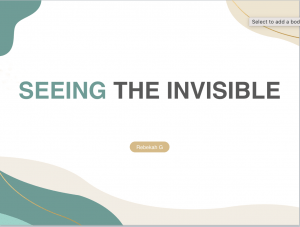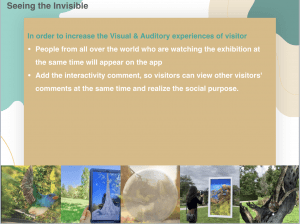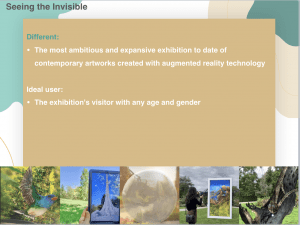During the time of the COVID-19 is increased our appetite for virtual interactions and for the great outdoors. And this exhibition “seeing the invisible” combines both. Michael explains that “coming out of the pandemic, when outdoor experiences and nature have taken on a new meaning and gravity in our lives, this exhibition represents a fresh way for people to engage with art and nature simultaneously.”
Although in many ways, it was a very successful and mature mobile placemaking project, there is still optimization space. In my opinion, interactivity plays an important role in augmented reality. It is an interactive medium where the objects that reside in the real world are enhanced by computer-generated perceptual information, sometimes across multiple sensory modalities, including visual, auditory, haptic, somatosensory, and olfactory experiences of a real-world environment. This exhibition is mainly focused on visual and auditory experiences. The first idea is that visitors from all over the world who are watching the exhibition at the same time will appear on the application. When visitors open the software and stand in front of the exhibition site according to the instructions, they will not only see gorgeous works of art but also see other visitors with virtual cartoon images walking around the artwork in front of them. In addition, they can also communicate with each other, and share interests and moods. Communication methods can be through real-time voice and instant messaging. Among them, communication with other visitors is not limited to verbal communication. For example, visitor A can invite visitor B to take a photo together, either with two virtual cartoon characters or both real and virtual, depending on the visitor’s setting.
To be honest, the difference between the application and others is dependent on the exhibition, because this is the most ambitious and expansive exhibition to date of contemporary artworks created with augmented reality technology. It is appearing across 12 participating gardens in seven countries. Seeing the Invisible places the same group of artworks across analogous locations in twelve outdoor settings situated in different biomes all around the world, creating parallels and contrasts between them. The ideal user is someone who wants to see the exhibition, because the exhibition can only be viewed by the application and the application is only useful for the specific scene. Therefore, the ideal user is only the exhibition’s visitor not limit any age and gender. If the purpose is to increase the target users, then we need to go bigger to promote the exhibition and attract more people to see it in order to have more users download the software.



